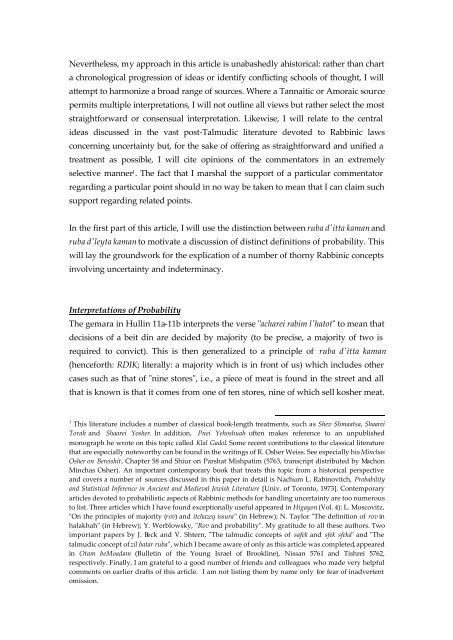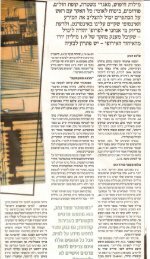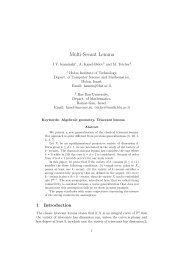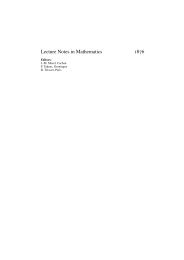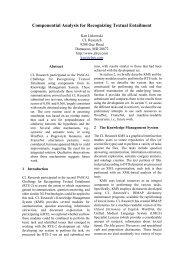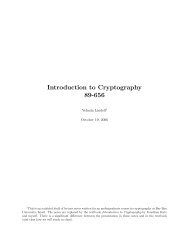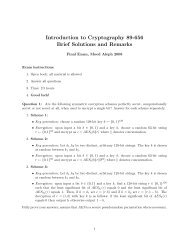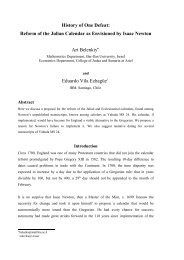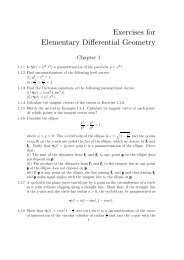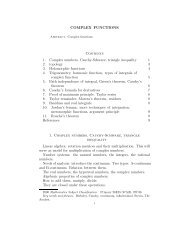Resolving Uncertainty: A Unified Overview of Rabbinic Methods
Resolving Uncertainty: A Unified Overview of Rabbinic Methods
Resolving Uncertainty: A Unified Overview of Rabbinic Methods
Create successful ePaper yourself
Turn your PDF publications into a flip-book with our unique Google optimized e-Paper software.
Nevertheless, my approach in this article is unabashedly ahistorical: rather than chart<br />
a chronological progression <strong>of</strong> ideas or identify conflicting schools <strong>of</strong> thought, I will<br />
attempt to harmonize a broad range <strong>of</strong> sources. Where a Tannaitic or Amoraic source<br />
permits multiple interpretations, I will not outline all views but rather select the most<br />
straightforward or consensual interpretation. Likewise, I will relate to the central<br />
ideas discussed in the vast post-Talmudic literature devoted to <strong>Rabbinic</strong> laws<br />
concerning uncertainty but, for the sake <strong>of</strong> <strong>of</strong>fering as straightforward and unified a<br />
treatment as possible, I will cite opinions <strong>of</strong> the commentators in an extremely<br />
selective manner 1 . The fact that I marshal the support <strong>of</strong> a particular commentator<br />
regarding a particular point should in no way be taken to mean that I can claim such<br />
support regarding related points.<br />
In the first part <strong>of</strong> this article, I will use the distinction between ruba d'itta kaman and<br />
ruba d'leyta kaman to motivate a discussion <strong>of</strong> distinct definitions <strong>of</strong> probability. This<br />
will lay the groundwork for the explication <strong>of</strong> a number <strong>of</strong> thorny <strong>Rabbinic</strong> concepts<br />
involving uncertainty and indeterminacy.<br />
Interpretations <strong>of</strong> Probability<br />
The gemara in Hullin 11a-11b interprets the verse "acharei rabim l'hatot" to mean that<br />
decisions <strong>of</strong> a beit din are decided by majority (to be precise, a majority <strong>of</strong> two is<br />
required to convict). This is then generalized to a principle <strong>of</strong> ruba d'itta kaman<br />
(henceforth: RDIK; literally: a majority which is in front <strong>of</strong> us) which includes other<br />
cases such as that <strong>of</strong> "nine stores", i.e., a piece <strong>of</strong> meat is found in the street and all<br />
that is known is that it comes from one <strong>of</strong> ten stores, nine <strong>of</strong> which sell kosher meat.<br />
1 This literature includes a number <strong>of</strong> classical book-length treatments, such as Shev Shmaatsa, Shaarei<br />
Torah and Shaarei Yosher. In addition, Pnei Yehoshuah <strong>of</strong>ten makes reference to an unpublished<br />
monograph he wrote on this topic called Klal Gadol. Some recent contributions to the classical literature<br />
that are especially noteworthy can be found in the writings <strong>of</strong> R. Osher Weiss. See especially his Minchas<br />
Osher on Bereishit, Chapter 58 and Shiur on Parshat Mishpatim (5763, transcript distributed by Machon<br />
Minchas Osher). An important contemporary book that treats this topic from a historical perspective<br />
and covers a number <strong>of</strong> sources discussed in this paper in detail is Nachum L. Rabinovitch, Probability<br />
and Statistical Inference in Ancient and Medieval Jewish Literature [Univ. <strong>of</strong> Toronto, 1973]. Contemporary<br />
articles devoted to probabilistic aspects <strong>of</strong> <strong>Rabbinic</strong> methods for handling uncertainty are too numerous<br />
to list. Three articles which I have found exceptionally useful appeared in Higayon (Vol. 4): L. Moscovitz,<br />
"On the principles <strong>of</strong> majority (rov) and itchazeq issura" (in Hebrew); N. Taylor "The definition <strong>of</strong> rov in<br />
halakhah" (in Hebrew); Y. Werblowsky, "Rov and probability". My gratitude to all these authors. Two<br />
important papers by J. Beck and V. Shtern, "The talmudic concepts <strong>of</strong> safek and sfek sfeka" and "The<br />
talmudic concept <strong>of</strong> zil batar ruba", which I became aware <strong>of</strong> only as this article was completed, appeared<br />
in Otam beMoadam (Bulletin <strong>of</strong> the Young Israel <strong>of</strong> Brookline), Nissan 5761 and Tishrei 5762,<br />
respectively. Finally, I am grateful to a good number <strong>of</strong> friends and colleagues who made very helpful<br />
comments on earlier drafts <strong>of</strong> this article. I am not listing them by name only for fear <strong>of</strong> inadvertent<br />
omission.


